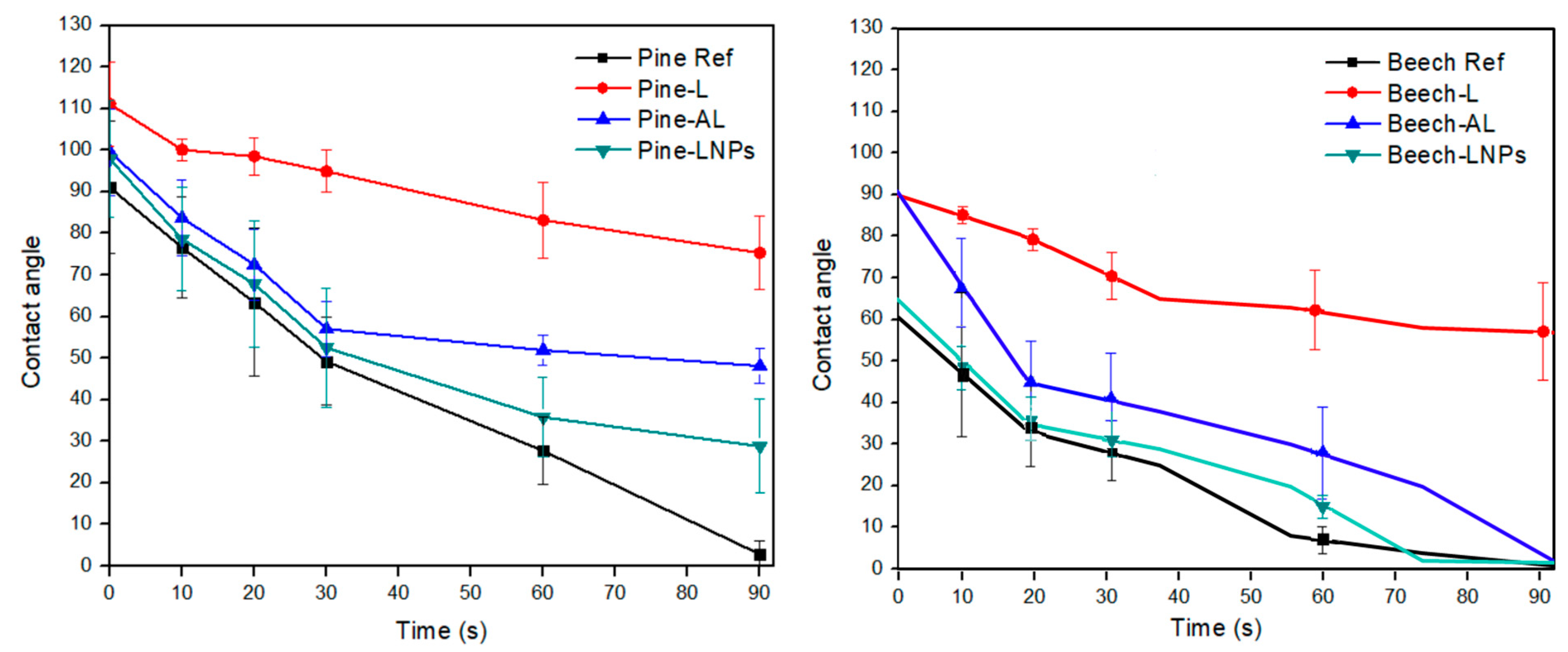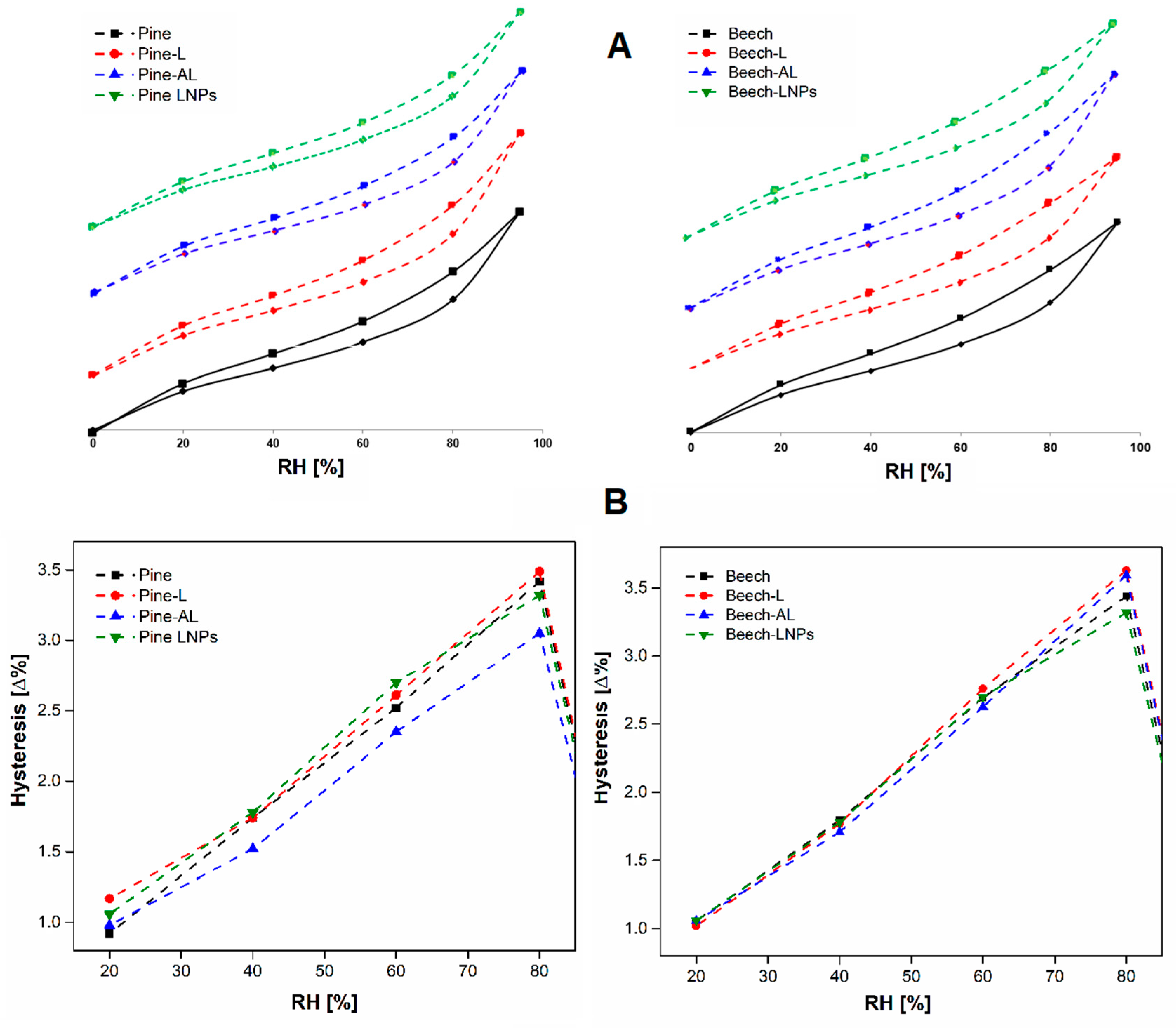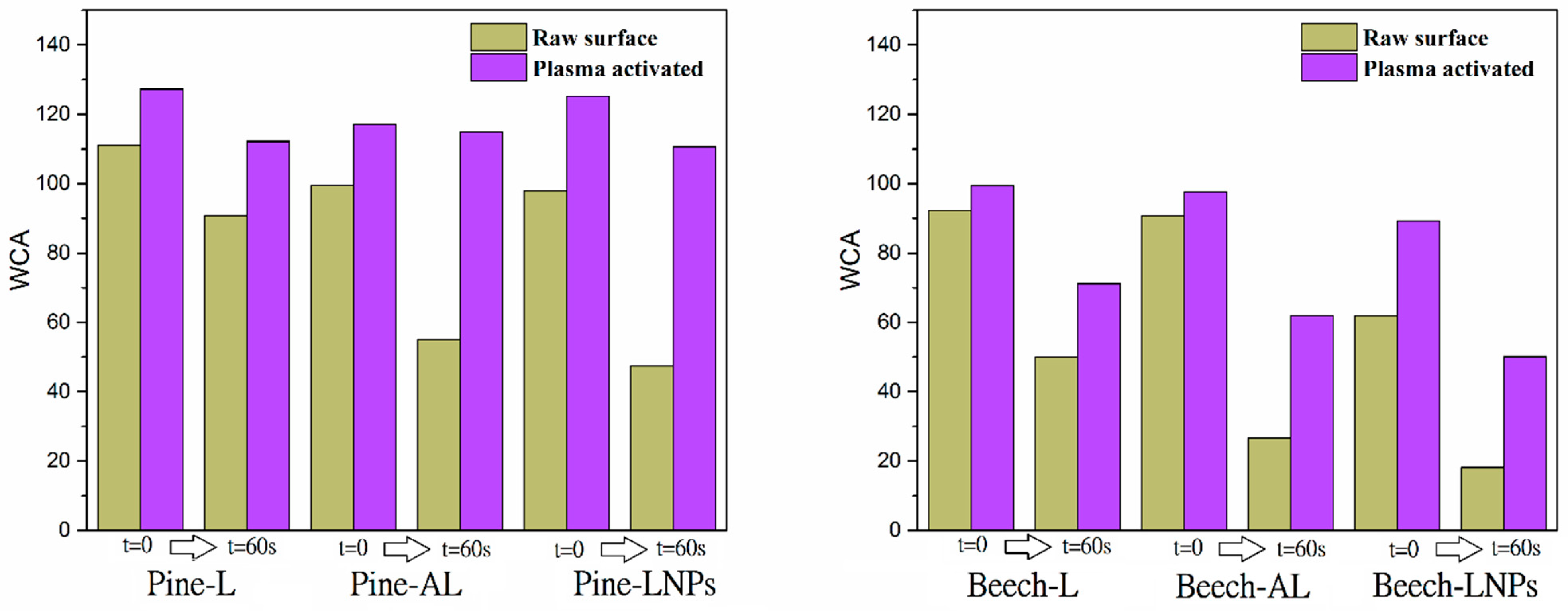Simultaneous Improvement of Surface Wettability and UV Resistance of Wood with Lignin-Based Treatments
Abstract
1. Introduction
2. Materials and Methods
2.1. Wood Material
2.2. Lignin Material
2.3. Impregnation Methodology
2.4. Samples Characterisation
2.4.1. Physical Properties
2.4.2. Wettability and Surface Free Energy
2.4.3. Dimensional Stability
2.4.4. UV Stability and Colour Changes
2.4.5. Thermal Stability
2.5. Product Performance
2.5.1. Measurement of Leachability and Performance
2.5.2. Surface Post Treatment by Plasma Technology
3. Results and Discussion
3.1. Physical Properties
3.2. Wetting Behaviour and Hygroscopic Properties
3.3. Colour Changes and UV Stability
3.4. Thermal Properties
3.5. Product Performance: Properties after Leaching Cycle
3.6. Improvement in Water Repellence: Plasma Treatment on Surface
4. Conclusions
Author Contributions
Funding
Data Availability Statement
Conflicts of Interest
References
- Ramage, M.H.; Burridge, H.; Busse-Wicher, M.; Fereday, G.; Reynolds, T.; Shah, D.U.; Wu, G.; Yu, L.; Fleming, P.; Densley-Tingley, D.; et al. The Wood from the Trees: The Use of Timber in Construction. Renew. Sustain. Energy Rev. 2017, 68, 333–359. [Google Scholar] [CrossRef]
- Himes, A.; Busby, G. Wood Buildings as a Climate Solution. Dev. Built Environ. 2020, 4, 100030. [Google Scholar] [CrossRef]
- Chen, C.; Kuang, Y.; Zhu, S.; Burgert, I.; Keplinger, T.; Gong, A.; Li, T.; Berglund, L.; Eichhorn, S.J.; Hu, L. Structure–Property–Function Relationships of Natural and Engineered Wood. Nat. Rev. Mater. 2020, 5, 642–666. [Google Scholar] [CrossRef]
- Sandak, A.; Sandak, J.; Dimitriou, A.; Burud, I.; Thiis, T.; Gobakken, L.R.; Ormondroyd, G.A.; Kraniotis, D. Assessment and Monitoring of Aesthetic Appearance of Building Biomaterials during the Service Life; WIT Press: Cambridge, MA, USA, 2017; pp. 527–536. [Google Scholar]
- Lie, S.K.; Vestøl, G.I.; Høibø, O.; Gobakken, L.R. Visual Appearance of Unpainted Wood: Mould Coverage, Lightness and Uniformity. Int. Wood Prod. J. 2019, 10, 9–15. [Google Scholar] [CrossRef]
- George, B.; Suttie, E.; Merlin, A.; Deglise, X. Photodegradation and Photostabilisation of Wood—The State of the Art. Polym. Degrad. Stab. 2005, 88, 268–274. [Google Scholar] [CrossRef]
- Petrillo, M.; Sandak, J.; Grossi, P.; Sandak, A. Chemical and Appearance Changes of Wood Due to Artificial Weathering—Dose–Response Model. J. Near Infrared Spectrosc. 2019, 27, 26–37. [Google Scholar] [CrossRef]
- Sandak, A.; Sandak, J.; Brzezicki, M.; Kutnar, A. Biomaterials for Building Skins; Springer: Berlin/Heidelberg, Germany, 2019; pp. 27–64. [Google Scholar]
- Sandberg, D.; Kutnar, A.; Mantanis, G. Wood Modification Technologies—A Review. iForest 2017, 10, 895–908. [Google Scholar] [CrossRef]
- Zelinka, S.L.; Altgen, M.; Emmerich, L.; Guigo, N.; Keplinger, T.; Kymäläinen, M.; Thybring, E.E.; Thygesen, L.G. Review of Wood Modification and Wood Functionalization Technologies. Forests 2022, 13, 1004. [Google Scholar] [CrossRef]
- Jirouš-Rajković, V.; Miklečić, J. Enhancing Weathering Resistance of Wood—A Review. Polymers 2021, 13, 1980. [Google Scholar] [CrossRef]
- Acosta, A.P.; Diaz, R.H.; Amico, S.C.; Beltrame, R.; Barbosa, K.T.; Delucis, R.A.; Gatto, D.A. Effect of the Temperature of the Heat Treatment of Pine Wood on Subsequent in Situ Polymerization with Poly(Methyl Methacrylate). Biofuels Bioprod. Biorefin. 2023, 17, 499–509. [Google Scholar] [CrossRef]
- Papadopoulos, A.N.; Bikiaris, D.N.; Mitropoulos, A.C.; Kyzas, G.Z. Nanomaterials and Chemical Modifications for Enhanced Key Wood Properties: A Review. Nanomaterials 2019, 9, 607. [Google Scholar] [CrossRef] [PubMed]
- Papadopoulos, A.N.; Taghiyari, H.R. Innovative Wood Surface Treatments Based on Nanotechnology. Coatings 2019, 9, 866. [Google Scholar] [CrossRef]
- Zevallos Torres, L.A.; Lorenci Woiciechowski, A.; de Andrade Tanobe, V.O.; Karp, S.G.; Guimarães Lorenci, L.C.; Faulds, C.; Soccol, C.R. Lignin as a Potential Source of High-Added Value Compounds: A Review. J. Clean. Prod. 2020, 263, 121499. [Google Scholar] [CrossRef]
- Zhang, Y.; Naebe, M. Lignin: A Review on Structure, Properties, and Applications as a Light-Colored UV Absorber. ACS Sustain. Chem. Eng. 2021, 9, 1427–1442. [Google Scholar] [CrossRef]
- Liao, J.J.; Latif, N.H.A.; Trache, D.; Brosse, N.; Hussin, M.H. Current Advancement on the Isolation, Characterization and Application of Lignin. Int. J. Biol. Macromol. 2020, 162, 985–1024. [Google Scholar] [CrossRef]
- Gordobil, O.; Herrera, R.; Llano-Ponte, R.; Labidi, J. Esterified Organosolv Lignin as Hydrophobic Agent for Use on Wood Products. Prog. Org. Coat. 2017, 103, 143–151. [Google Scholar] [CrossRef]
- Zikeli, F.; Vinciguerra, V.; D’Annibale, A.; Capitani, D.; Romagnoli, M.; Scarascia Mugnozza, G. Preparation of Lignin Nanoparticles from Wood Waste for Wood Surface Treatment. Nanomaterials 2019, 9, 281. [Google Scholar] [CrossRef] [PubMed]
- Avramidis, G.; Hauswald, E.; Lyapin, A.; Militz, H.; Viöl, W.; Wolkenhauer, A. Plasma Treatment of Wood and Wood-Based Materials to Generate Hydrophilic or Hydrophobic Surface Characteristics. Wood Mater. Sci. Eng. 2009, 4, 52–60. [Google Scholar] [CrossRef]
- Kienberger, M.; Maitz, S.; Pichler, T.; Demmelmayer, P. Systematic Review on Isolation Processes for Technical Lignin. Processes 2021, 9, 804. [Google Scholar] [CrossRef]
- Buono, P.; Duval, A.; Verge, P.; Averous, L.; Habibi, Y. New Insights on the Chemical Modification of Lignin: Acetylation versus Silylation. ACS Sustain. Chem. Eng. 2016, 4, 5212–5222. [Google Scholar] [CrossRef]
- Gordobil, O.; Li, H.; Izquierdo, A.A.; Egizabal, A.; Sevastyanova, O.; Sandak, A. Surface Chemistry and Bioactivity of Colloidal Particles from Industrial Kraft Lignins. Int. J. Biol. Macromol. 2022, 220, 1444–1453. [Google Scholar] [CrossRef] [PubMed]
- Gao, Y.; Li, Y.; Ren, R.; Li, L.; Chen, Y. Enhanced Mechanical and Humidity Resistance Properties of Heat-Treated Wood by Impregnation of Low-Molecular-Weight Lignin. Wood Sci. Technol. 2022, 56, 1551–1565. [Google Scholar] [CrossRef]
- Wen, M.-Y.; Kang, C.-W.; Park, H.-J. Impregnation and Mechanical Properties of Three Softwoods Treated with a New Fire Retardant Chemical. J. Wood Sci. 2014, 60, 367–375. [Google Scholar] [CrossRef]
- Tondi, G.; Thevenon, M.F.; Mies, B.; Standfest, G.; Petutschnigg, A.; Wieland, S. Impregnation of Scots Pine and Beech with Tannin Solutions: Effect of Viscosity and Wood Anatomy in Wood Infiltration. Wood Sci. Technol. 2013, 47, 615–626. [Google Scholar] [CrossRef]
- Laina, R.; Sanz-Lobera, A.; Villasante, A.; López-Espí, P.; Martínez-Rojas, J.A.; Alpuente, J.; Sánchez-Montero, R.; Vignote, S. Effect of the Anatomical Structure, Wood Properties and Machining Conditions on Surface Roughness of Wood. Maderas. Cienc. Tecnol. 2017, 19, 203–212. [Google Scholar] [CrossRef][Green Version]
- Sadeghifar, H.; Argyropoulos, D.S. Correlations of the Antioxidant Properties of Softwood Kraft Lignin Fractions with the Thermal Stability of Its Blends with Polyethylene. ACS Sustain. Chem. Eng. 2015, 3, 349–356. [Google Scholar] [CrossRef]
- Hwang, U.; Lee, B.; Oh, B.; Shin, H.S.; Lee, S.S.; Kang, S.G.; Kim, D.; Park, J.; Shin, S.; Suhr, J.; et al. Hydrophobic Lignin/Polyurethane Composite Foam: An Eco-Friendly and Easily Reusable Oil Sorbent. Eur. Polym. J. 2022, 165, 110971. [Google Scholar] [CrossRef]
- Herrera Díaz, R.; Gordobil, O.; de Hoyos-Martinez, P.L.; Sandak, A.; Labidi, J. Hydrophobization and Photo-Stabilization of Radiata Pinewood: The Effect of the Esterification on Thermal and Mechanical Properties. Forests 2020, 11, 1243. [Google Scholar] [CrossRef]
- Hou, S.; Wang, J.; Yin, F.; Qi, C.; Mu, J. Moisture Sorption Isotherms and Hysteresis of Cellulose, Hemicelluloses and Lignin Isolated from Birch Wood and Their Effects on Wood Hygroscopicity. Wood Sci. Technol. 2022, 56, 1087–1102. [Google Scholar] [CrossRef]
- Irbe, I.; Andersons, B.; Chirkova, J.; Kallavus, U.; Andersone, I.; Faix, O. On the Changes of Pinewood (Pinus sylvestris L.) Chemical Composition and Ultrastructure during the Attack by Brown-Rot Fungi Postia placenta and Coniophora puteana. Int. Biodeterior. Biodegrad. 2006, 57, 99–106. [Google Scholar] [CrossRef]
- Hill, C.A.S.; Norton, A.; Newman, G. The Water Vapor Sorption Behavior of Natural Fibers. J. Appl. Polym. Sci. 2009, 112, 1524–1537. [Google Scholar] [CrossRef]
- Almeida, G.; Rémond, R.; Perré, P. Hygroscopic Behaviour of Lignocellulosic Materials: Dataset at Oscillating Relative Humidity Variations. J. Build. Eng. 2018, 19, 320–333. [Google Scholar] [CrossRef]
- Sadeghifar, H.; Ragauskas, A. Lignin as a UV Light Blocker—A Review. Polymers 2020, 12, 1134. [Google Scholar] [CrossRef] [PubMed]
- De Hoyos-Martínez, P.L.; Issaoui, H.; Herrera, R.; Labidi, J.; Charrier-El Bouhtoury, F. Wood Fireproofing Coatings Based on Biobased Phenolic Resins. ACS Sustain. Chem. Eng. 2021, 9, 1729–1740. [Google Scholar] [CrossRef]
- Popescu, C.; Pfriem, A. Treatments and Modification to Improve the Reaction to Fire of Wood and Wood Based Products—An Overview. Fire Mater. 2020, 44, 100–111. [Google Scholar] [CrossRef]
- Zikeli, F.; Romagnoli, M.; Mugnozza, G.S. Lignin Nanoparticles in Coatings for Wood Preservation. In Micro and Nanolignin in Aqueous Dispersions and Polymers; Elsevier: Amsterdam, The Netherlands, 2022; pp. 357–384. [Google Scholar]
- Lux, C.; Szalay, Z.; Beikircher, W.; Kováčik, D.; Pulker, H.K. Investigation of the Plasma Effects on Wood after Activation by Diffuse Coplanar Surface Barrier Discharge. Eur. J. Wood Wood Prod. 2013, 71, 539–549. [Google Scholar] [CrossRef]
- Jablonský, M.; Šmatko, L.; Botková, M.; Tiňo, R.; Šima, J. Modification of Wood Wettability (European Beech) by Diffuse Coplanar Surface Barrier Discharge Plasma. Surfaces 2016, 28, 30. [Google Scholar]
- Talviste, R.; Galmiz, O.; Stupavská, M.; Ráhel’, J. Effect of DCSBD Plasma Treatment Distance on Surface Characteristics of Wood and Thermally Modified Wood. Wood Sci. Technol. 2020, 54, 651–665. [Google Scholar] [CrossRef]





| Specimen | WPG [%] * | Absorption Dose [%] | MC (65% RH–25 °C) [%] * | Density [kg/m3] * | Increase in Density [%] |
|---|---|---|---|---|---|
| Pine Ref | - | - | 8.49 (0.37) | 437.84 (13.67) | - |
| Pine-L | 2.15 (0.27) | 10.38 | 8.07 (0.32) | 450.22 (13.87) | 2.14 |
| Pine-AL | 2.09 (0.20) | 9.80 | 7.53 (0.24) | 444.27 (15.12) | 2.09 |
| Pine-LNPs | 1.98 (0.28) | 9.84 | 7.80 (0.25) | 445.84 (11.84) | 1.89 |
| Beech Ref | - | - | 6.93 (0.50) | 741.21 (28.94) | - |
| Beech-L | 0.81 (0.20) | 8.91 | 8.08 (0.16) | 749.72 (28.87) | 0.77 |
| Beech-AL | 0.74 (0.18) | 8.82 | 8.14 (0.16) | 754.04 (27.39) | 0.63 |
| Beech-LNPs | 1.24 (0.27) | 8.63 | 7.25 (0.41) | 739.59(26.91) | 1.27 |
| Specimen | WCA [°] | FCA [°] | DCA [°] | Surface Free Energy [mJ/m²] | ||
|---|---|---|---|---|---|---|
| γPolar | γdisperse | γTOTAL | ||||
| Pine Ref | 91.0 (6.31) ** | 25.9 (3.56) * | 31.9 (3.89) * | 2.5 | 47.7 | 50.2 |
| Pine-L | 111.1 (5.78) *** | 50.3 (4.32) * | 11.3 (1.14) ** | 0.5 | 57.5 | 60.0 |
| Pine-AL | 99.6 (5.37) *** | 49.6 (4.21) * | 10.1 (1.12) ** | 0.3 | 57.1 | 57.4 |
| Pine-LNPs | 97.9 (5.96) ** | 26.6 (2.45) * | 32.3 (3.78) * | 0.8 | 51.1 | 51.9 |
| Beech Ref | 56.8 (5.56) ** | 31.7 (2.55) ** | 17.2 (2.22) * | 7.3 | 44.3 | 51.6 |
| Beech-L | 92.3 (4.06) * | 39.9 (3.89) ** | 12.2 (1.65) * | 2.7 | 48.2 | 50.9 |
| Beech-AL | 90.7 (4.59) * | 28.7 (2.66) ** | 16.3 (2.47) * | 0.1 | 57.6 | 57.7 |
| Beech-LNPs | 61.8 (4.69) ** | 43.2 (3.88) ** | 12.8 (1.47) * | 4.7 | 44.7 | 49.4 |
| Specimen | Initial Colour | Colour after UV Radiation | Δcolour | ||||
|---|---|---|---|---|---|---|---|
| L | a | b | L | a | b | ||
| Pine Ref | 82.27 (0.42) *** | 4.75 (0.32) ** | 22.86 (0.29) *** | 68.73 (1.89) ** | 13.07 (0.56) ** | 39.49 (0.77) *** | 23.0 |
| Pine-L | 65.89 (1.23) * | 9.45 (0.89) *** | 27.41 (0.26) *** | 60.08 (0.65) * | 14.35 (0.28) *** | 37.86 (0.49) * | 13.0 |
| Pine-AL | 79.24 (0.85) *** | 5.55 (0.55) ** | 26.49 (0.31) *** | 67.60 (0.33) ** | 12.08 (0.72) ** | 37.74 (0.44) * | 17.6 |
| Pine-LNPs | 66.56 (0.38) * | 11.38 (0.76) *** | 24.87 (0.21) *** | 60.19 (1.25) * | 13.57 (0.60) ** | 34.97 (0.12) *** | 12.2 |
| Beech Ref | 68.55 (1.02) *** | 10.29 (1.18) * | 20.52 (0.12) *** | 62.52 (1.23) ** | 12.77 (0.33) * | 27.90 (0.42) *** | 9.9 |
| Beech-L | 54.90 (1.56) *** | 13.07 (1.45) ** | 25.40 (0.66) * | 52.63 (0.62) *** | 14.62 (0.56) *** | 29.93 (0.46) * | 5.4 |
| Beech-AL | 65.64 (1.12) ** | 10.20 (0.88) * | 25.73 (0.42) * | 61.38 (0.29) ** | 12.17 (0.32) ** | 29.42 (0.30) * | 6.0 |
| Beech-LNPs | 63.93 (0.96) ** | 11.85 (0.94) ** | 24.42 (0.22) *** | 58.90 (0.90) *** | 13.09 (0.74) * | 29.39 (0.48) * | 7.3 |
| Specimen | T10 (°C) | T50 (°C) | Tmax (°C) | Residue at 800 °C (%) |
|---|---|---|---|---|
| Pine Ref | 274.7 | 351.6 | 352.8 | 14.3 |
| Pine-L | 261.9 | 325.8 | 319.7 | 21.1 |
| Pine-AL | 251.4 | 331.4 | 325.2 | 20.9 |
| Pine-LNPs | 269.8 | 353.2 | 355.1 | 15.5 |
| Beech Ref | 264.9 | 341.3 | 344.6 | 17.3 |
| Beech-L | 261.2 | 336.4 | 337.9 | 22.7 |
| Beech-AL | 263.7 | 332.7 | 335.5 | 22.0 |
| Beech-LNPs | 268.5 | 343.2 | 346.2 | 16.9 |
| Specimen | WPG Loss after Leaching [%] | Product Retained [%] | WCA after Leaching (t = 60 s) | Colour Changes | |||
|---|---|---|---|---|---|---|---|
| ΔL | Δa | Δb | Δcolour | ||||
| Pine Ref | - | - | 24.88 | 0.9 | 0.0 | 0.3 | 0.9 |
| Pine-L | −0.62 (0.27) | 71.16 | 90.80 | 1.3 | 0.5 | −1.5 | 2.1 |
| Pine-AL | −0.46 (0.10) | 77.99 | 55.10 | 6.7 | −1.3 | −0.9 | 6.8 |
| Pine-LNPs | −0.47 (0.14) | 76.26 | 47.43 | −5.7 | 2.8 | −0.8 | 5.8 |
| Beech Ref | - | - | 10.65 | 6.7 | 0.1 | −2.2 | 7.1 |
| Beech-L | −0.80 (0.33) | 1.24 | 49.95 | −7.8 | 2.5 | 2.3 | 8.5 |
| Beech-AL | −0.47 (0.09) | 36.47 | 26.65 | 4.8 | −0.3 | −1.9 | 5.2 |
| Beech-LNPs | −0.52 (0.17) | 58.06 | 18.16 | 0.3 | 0.9 | 0.3 | 1.0 |
Disclaimer/Publisher’s Note: The statements, opinions and data contained in all publications are solely those of the individual author(s) and contributor(s) and not of MDPI and/or the editor(s). MDPI and/or the editor(s) disclaim responsibility for any injury to people or property resulting from any ideas, methods, instructions or products referred to in the content. |
© 2023 by the authors. Licensee MDPI, Basel, Switzerland. This article is an open access article distributed under the terms and conditions of the Creative Commons Attribution (CC BY) license (https://creativecommons.org/licenses/by/4.0/).
Share and Cite
Herrera, R.; Poohphajai, F.; Sandak, A.; Gordobil, O. Simultaneous Improvement of Surface Wettability and UV Resistance of Wood with Lignin-Based Treatments. Polymers 2023, 15, 3409. https://doi.org/10.3390/polym15163409
Herrera R, Poohphajai F, Sandak A, Gordobil O. Simultaneous Improvement of Surface Wettability and UV Resistance of Wood with Lignin-Based Treatments. Polymers. 2023; 15(16):3409. https://doi.org/10.3390/polym15163409
Chicago/Turabian StyleHerrera, Rene, Faksawat Poohphajai, Anna Sandak, and Oihana Gordobil. 2023. "Simultaneous Improvement of Surface Wettability and UV Resistance of Wood with Lignin-Based Treatments" Polymers 15, no. 16: 3409. https://doi.org/10.3390/polym15163409
APA StyleHerrera, R., Poohphajai, F., Sandak, A., & Gordobil, O. (2023). Simultaneous Improvement of Surface Wettability and UV Resistance of Wood with Lignin-Based Treatments. Polymers, 15(16), 3409. https://doi.org/10.3390/polym15163409









